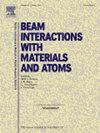UVC irradiation of alpha particles tracks and empirical equation of bulk etch rate in CR-39 detector
IF 1.4
3区 物理与天体物理
Q3 INSTRUMENTS & INSTRUMENTATION
Nuclear Instruments & Methods in Physics Research Section B-beam Interactions With Materials and Atoms
Pub Date : 2025-02-01
DOI:10.1016/j.nimb.2024.165596
引用次数: 0
Abstract
The first empirical equation is presented in this paper to characterize the behavior of the bulk etch rate (Vb) with the UVC dose. The Vb value increased nonlinearly with UVC irradiation during the initial dose of up to 13 J, then remained almost constant with prolonged UVC doses from 13 to 45 J. The alpha track depths in CR-39 were analyzed with UVC irradiation (λ = 254 nm). Samples exposed to UVC radiation achieved the maximum track depth with a shorter etching time than samples not exposed to UVC radiation. The Vt values increased significantly for samples exposed to UVC up to 7.1, 7.0, and 6.9 µm/h, respectively, at alpha energies of 2.5, 3.5, and 4.5 MeV. While the etch rate ratio decreased for the same samples.
CR-39探测器中α粒子的UVC辐照轨迹及体蚀速率的经验方程
本文提出了第一个经验方程来表征体蚀速率(Vb)随UVC剂量的变化规律。在初始剂量为13 J时,Vb值随UVC辐照量的增加呈非线性增加,随着UVC辐照量的增加,Vb值在13 ~ 45 J期间基本保持不变。暴露于UVC辐射下的样品比未暴露于UVC辐射下的样品在更短的蚀刻时间内获得了最大的轨迹深度。当α能量分别为2.5、3.5和4.5 MeV时,UVC浓度分别为7.1、7.0和6.9 μ m/h时,样品的Vt值显著增加。而相同样品的蚀刻速率比减小。
本文章由计算机程序翻译,如有差异,请以英文原文为准。
求助全文
约1分钟内获得全文
求助全文
来源期刊
CiteScore
2.80
自引率
7.70%
发文量
231
审稿时长
1.9 months
期刊介绍:
Section B of Nuclear Instruments and Methods in Physics Research covers all aspects of the interaction of energetic beams with atoms, molecules and aggregate forms of matter. This includes ion beam analysis and ion beam modification of materials as well as basic data of importance for these studies. Topics of general interest include: atomic collisions in solids, particle channelling, all aspects of collision cascades, the modification of materials by energetic beams, ion implantation, irradiation - induced changes in materials, the physics and chemistry of beam interactions and the analysis of materials by all forms of energetic radiation. Modification by ion, laser and electron beams for the study of electronic materials, metals, ceramics, insulators, polymers and other important and new materials systems are included. Related studies, such as the application of ion beam analysis to biological, archaeological and geological samples as well as applications to solve problems in planetary science are also welcome. Energetic beams of interest include atomic and molecular ions, neutrons, positrons and muons, plasmas directed at surfaces, electron and photon beams, including laser treated surfaces and studies of solids by photon radiation from rotating anodes, synchrotrons, etc. In addition, the interaction between various forms of radiation and radiation-induced deposition processes are relevant.

 求助内容:
求助内容: 应助结果提醒方式:
应助结果提醒方式:


